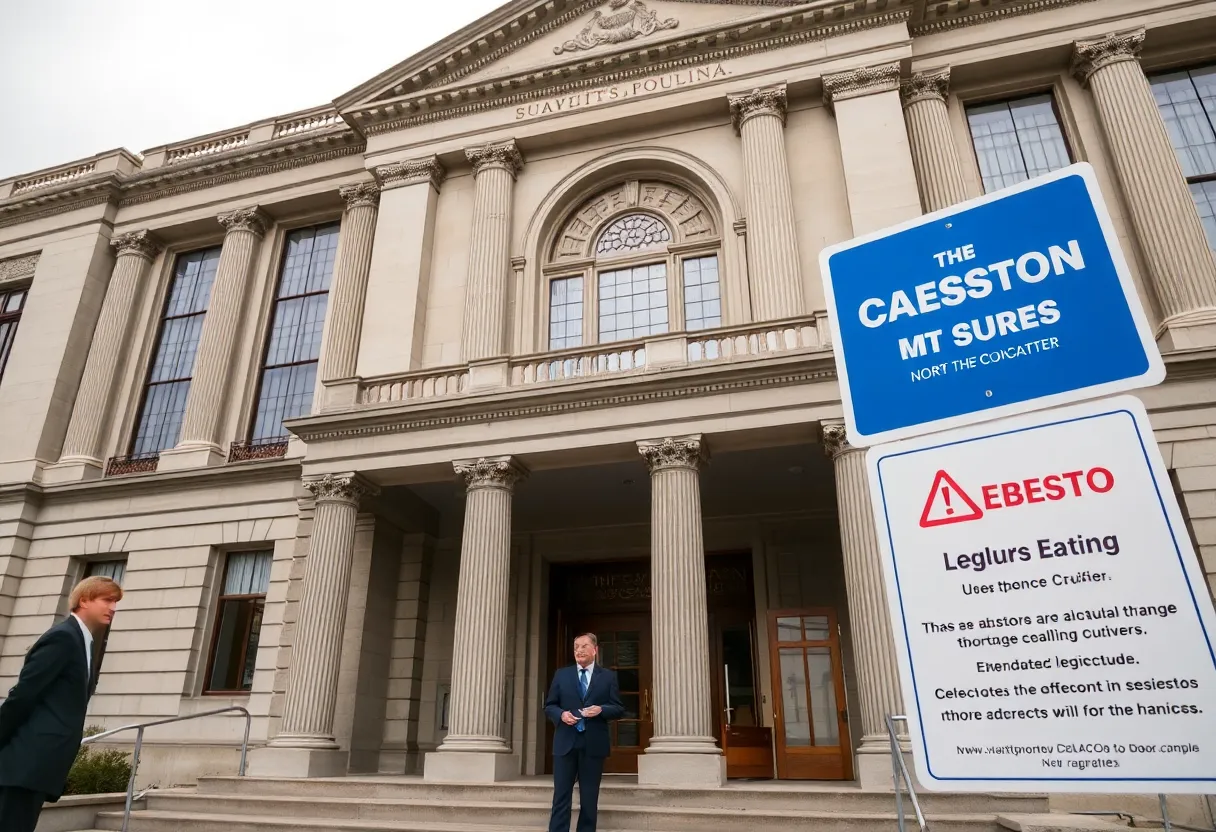News Summary
The discovery of asbestos in the North Carolina legislative building raises serious concerns about air quality and safety for lawmakers and the public.
Concerns Grow Over Asbestos Risks in North Carolina Legislative Building
The issues of asbestos exposure are back in the spotlight in North Carolina, particularly following revelations regarding the state legislative building. Representative Maria Cervania’s recent discovery of a warning sign indicating the presence of asbestos has stirred considerable anxiety among her colleagues. It was revealed that an air filter had to be installed in her office after this unsettling finding, raising alarms about the air quality within the building.
Aging Infrastructure and Asbestos Dangers
This legislative building, over 60 years old, originally utilized asbestos as a fire prevention material—a common practice during its time of construction. The ongoing removal of this hazardous material has been a prolonged procedure, often coinciding with other repair works. Yet, it appears transparency is scarce. Reports indicate no advance notifications were provided to lawmakers about the asbestos removal work that was being conducted. This lack of communication has raised significant fears, particularly concerning the safety of individuals working in the building.
Uncertainty Amidst Legislative Work
While legislative leaders, such as Senator Phil Berger, show a general indifference to the situation, Cervania is demanding more accountability from the Legislative Services Office. Legislative Services Officer Paul Coble has attempted to reassure employees by stating that the work is scheduled for nights and weekends to minimize disruption. Calming the public, he pledged that there was no immediate risk to anyone in the building, with the work being closely monitored by longstanding vendors and the NC Department of Health and Human Services.
Contamination Concerns: Time is of the Essence
Yet, Cervania emphasizes that the mere presence of asbestos poses significant contamination risks. It takes up to 80 hours for asbestos particles to settle, creating the potential for dangerous air quality, especially in a public building frequented by citizens and particularly schoolchildren on tours. The alarming trend of sealing off asbestos warnings during daytime operations raises even more eyebrows regarding the ongoing safety of building occupants.
National Snapshot: Asbestos Hazards Are Far From Isolated
The situation in North Carolina is not unique; similar concerns ripple through numerous educational institutions across the nation. Schools like Bowdoinham Community School in Maine have had to delay their academic year due to the discovery of asbestos in their insulation. In Ohio, ACCEL Schools is working to rectify asbestos issues after an EPA directive highlighted their lack of a management plan.
Tightening Scrutiny and Legal Battles
The conversation about asbestos isn’t merely about physical risks; it extends into the complicated legal landscape surrounding asbestos-related lawsuits. For decades, individuals diagnosed with illnesses linked to asbestos exposure have filed lawsuits. Recently, some corporations have employed strategies like the “Texas Two-Step” to shift liabilities and stall claims by filing for bankruptcy through subsidiaries.
Currently, the financial burden of managing and remediating asbestos hazards disproportionately affects schools and local communities. This has incited public outcry for accountability from corporations thought to be responsible for exposure. The complex web of legal obligations related to asbestos is undergoing critical review by courts, including potential examination by the U.S. Supreme Court.
A National Epidemic of Asbestos Discovery
Particularly worrying is the fact that almost half of U.S. schools built before the late 20th century are likely to contain asbestos—a reality posing grave risks to custodians, teachers, and students alike. In a haunting echo of this issue, numerous teachers have found themselves battling asbestos-related illnesses and seeking justice against school districts.
As communities navigate the murky waters of asbestos management and remediation, the call for better transparency and accountability continues to grow. The ongoing struggle with hazardous materials is not merely a legal issue but a matter of public safety that demands immediate action and reform.
Deeper Dive: News & Info About This Topic
HERE Resources
Breaking News: The Vital Importance of Early Detection in Cancer Survival Rates
Vivace Therapeutics Secures $35 Million in Series D Financing to Propel Mesothelioma Treatment
Mesothelioma Settlements: What You Need to Know About Tax Implications
The Fight Against Mesothelioma: New Insight into Cell Heterogeneity
Tenant Concerns Stir Up Storm at Worcester Housing Meeting
Former Austin Motor Employee Seeks Help After Mesothelioma Diagnosis
Urgent Call to Action for Louisiana Navy Veterans Diagnosed with Mesothelioma
Ohio Workers Face Asbestos-Related Health Risks Post 1982
Illinois Jury Awards $770,000 to Widow of Plumber Exposed to Asbestos
Controversial Asbestos Bill Passes in Montana as BNSF Faces Legal Fallout
Additional Resources
- WRAL: Asbestos Removal at North Carolina Legislature
- Wikipedia: Asbestos
- Charlotte Observer: Local Crime Report
- Google Search: Asbestos Removal North Carolina
- Asbestos.com: Asbestos Risks in Schools
- Google Scholar: Asbestos Legal Issues
- USA Today: North Carolina Cancer Cases
- Encyclopedia Britannica: Asbestos



















